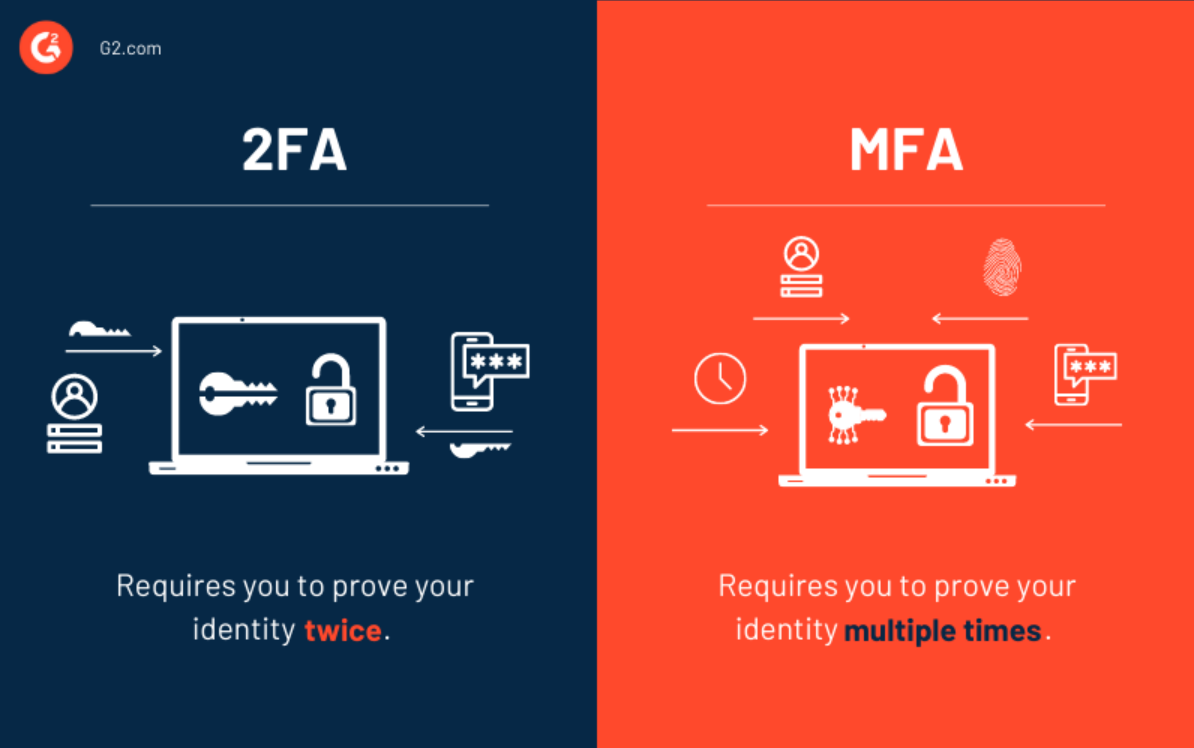- On Oct 21, 2022 1:09:37 PM
- by: Joe Rudolph
- 7 minutes Read
When it comes to protecting your organization’s information, it’s always better to be proactive. One of the most important proactive approaches? Multi-factor authentication (MFA).
It’s estimated that, when a breach to your cybersecurity defenses occurs, a reactive approach can cost small teams $55,000. At the same time, a larger organization can suffer $824,000 in losses.
It’s now common for cybersecurity insurance premiums to require that organizations use MFA. With soaring insurance rates, IT risk management is a new priority.
In this advanced technological world we’re living in, using only one element of authentication isn’t enough to ensure your personal and professional data stays private. That’s where the benefits of multi-factor authentication (MFA) approach come in to help.
What is multi-factor authentication?
MFA is a process by which multiple identifying authenticators are used to protect against unwanted online intruders. Incorporating MFA enhances your organization’s cybersecurity because each measure must be met to gain access.
Even if a hacker can crack a password, they must present additional requirements to breach the barriers. MFA includes at least these following authenticators:
- Something You Know (password or pin)
- Something You Have (code from an identification device)
- Something You Are (biometric fingerprint scan)
For example, for someone to gain access to a system, they need to input a password, put in a code from a device, and then use a fingerprint scan to get access.
One of the newest but most important forms of MFA is passwordless authentication. The United States government recently issued guidance on this on January 26, citing the W3C’s Web Authentication’ standard as an effective approach. It enables biometric passwordless authentication on devices, and when done right, is almost impervious to hacking.
Why? There are no credentials to steal, and devices only authenticate to trusted sites that have been authenticated previously. Plus, it’s easier than remembering various passwords.
Microsoft is also an advocate for passwordless authentication, stating that organizations might adopt this proactive cybersecurity approach for several reasons:
- Stronger IT defenses to protect against cyber-attacks
- Support for remote working
- Adoption of a “Zero Trust” approach
- And more.
Interested in seeing how protected your organization is? Take our less-than-a-minute risk assessment to learn what you can do to lessen your cybersecurity risks.
What is the difference between the benefits of MFA vs. 2FA?
A hacker with bad intentions would need at least a password to gain access to protected information. However, using just a password may elevate your risk of a breach, given that since COVID-19, data breaches have increased by 273%.
This means that your organization should have, at the very least, two-factor authentication (2FA). 2FA is a system of protection that uses two authenticating pieces of information, most commonly a password plus a randomly generated PIN or code. You’ll commonly see this in your personal life when you get a text or email with a code from your bank to verify your identity when you try to sign in.

The difference between 2FA and MFA is that MFA requires more than two authentication elements. If an ATM also required fingerprint or facial recognition authentication, it would meet all MFA requirements. In comparison, 2FA is a commonly used form of MFA. It greatly reduces the possibility of your account being hacked, which meets most organizations’ security needs. However, when an organization is dealing with highly sensitive data, it may need to rely on all three factors rather than just two.
So, what are the specific benefits of multi-factor authentication for an organization?
1. MFA Adds a Critical Layer of Security
More sophisticated passwords indeed make it harder for a hacker to gain access, but it doesn’t make it impossible. The problem with password protection is that it takes extra work to make it effective.
Typical recommendations for effective passwords include using long mixed character choices and changing credentials frequently, causing people to go with what they know.
In fact,67% of all Americans use the same password on all of their personal and professional accounts. This means that if one account is compromised, all of them are susceptible. Furthermore, the hassle of frequently creating new passwords often leads to people choosing familiar phrases. Common credentials include favorite sports teams or a pet’s name, or worse passwords like “12345” or “password,” all of which are easy to guess.
Requiring MFA to access valuable company information adds additional layers of protection against cybersecurity risk. Relying on passwords alone is risky, because humans often reuse passwords to remember them. By adding those extra barriers, your business increases security.
2. MFA Limits Who Has Access to Information
Though outsourcing aspects of your business have a host of benefits, it carries a higher risk regarding security. If you outsource any of your company’s activities to a third-party vendor, they have access to intelligence information.Your security then becomes as susceptible as theirs.
How real is the threat of a third-party leak? In one investigation of 450 global data breaches,63% of them were tied back to a third-party vendor.
Requiring vendors ormanaged service providers to access your data with more than one piece of authenticating information limits who has access to it. As you hand over your sensitive information, keep in mind that 99.9% of monthly compromised Microsoft accounts do not have MFA. This benefit of multi-factor authentication consists of limiting those who have access to your company information by:
- Ensuring only authorized users get access
- Adding extra layers of authentication
- Limiting the number of people assigned
3. MFA Qualifies Your Business for Cybersecurity Insurance
We’ve already discussed the costs of a cyber-attack and how your organization might be vulnerable. The increased threats in the past few years have made your data such a target that many cybersecurity liability insurance rates are skyrocketing.
Cyber insurance is protection against the financial fallout of a breach. Any online user is susceptible to an attack, and protecting your organization against potential leaks should be a priority.
Each insurance provider will have its own unique requirements, like requiring that organizations have regularend user cybersecurity awareness training. Almost all providers require that MFA is part of your business practice to get their offered protection, making this benefit of multi-factor authentication a necessity.
And even if your insurance provider doesn’t require MFA, having it can lower your premiums. With organizations facing rapidly rising premiums, taking actions like these can be the factor that helps you avoid double-digit percentage increases in your annual premiums!
4. MFA Helps You Meet Regulatory Compliance
While running operations and conducting transactions, your organization is liable for protecting certain information. Trust enhances public relations, and regulations govern specific behaviors for handling sensitive information.
The most common regulations center around protecting identity, financial information, and disclosing how privacy is protected. Incorporating MFA helps your organization ensure that regulations are compliant, such as with:
- HIPAA
- SOC 2
- PCI-DSS
- GLBA
5. MFA Helps Protect Your Company and Employees
Cybersecurity has become a heightened topic of concern in both personal and professional settings. Suppose you’re a C-level employee or a high-level manager within your organization, but like most internet users, you use the same passwords at home and at work. If this is true, you could be elevating your organization’s cybersecurity risk.
Even if you’re not like the vast majority of online consumers using the same passwords, there is a high chance that someone within your organization is. All it takes is one data breach to cost your business not only money, but time and trust.
A cyber attack on a company can result in:
- Loss of Revenue
- Public mistrust of your company
- Intelligence loss
- Legal fees and fines
- And more.
The Benefits of Multi-Factor Authentication Are Second to None
Cyberattack approaches are becoming more sophisticated and pervasive, and its damages are devastating. A breach in your organization's data can result in lost revenue and public mistrust.
That’s why security requires a proactive approach to a problem already existing. Since many organizations are struggling to keep up with their cybersecurity needs and rising cyber liability insurance rates, many choose to trust a MSP cybersecurity partner to rely on in their day to day life.
Protect your organization and lower your cybersecurity insurance premiums by requiring MFA for your employees and any third-party vendors. The extra steps of authentication have a significant impact on your bottom line, and have numerous advantages that can’t be put off.
Interested in learning more about the benefits of multi-factor authentication? Speak with the cybersecurity pros at Ceeva to discuss how we can help protect your data.
Subscribe blog for latest updates
By submitting this you will be receiving our latest updates on post.
